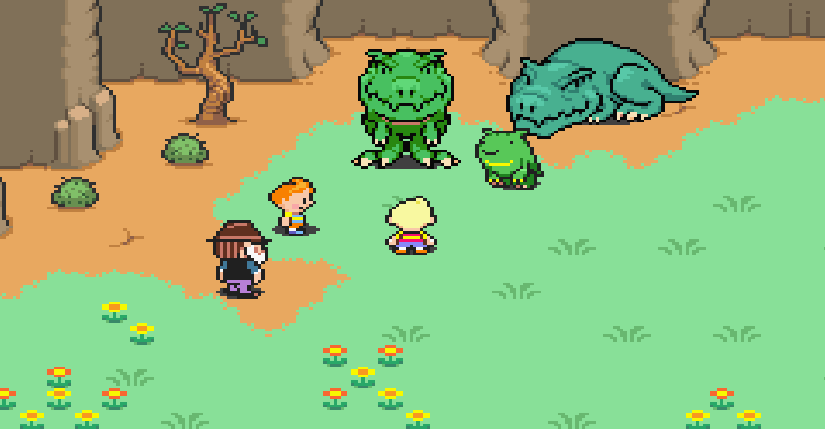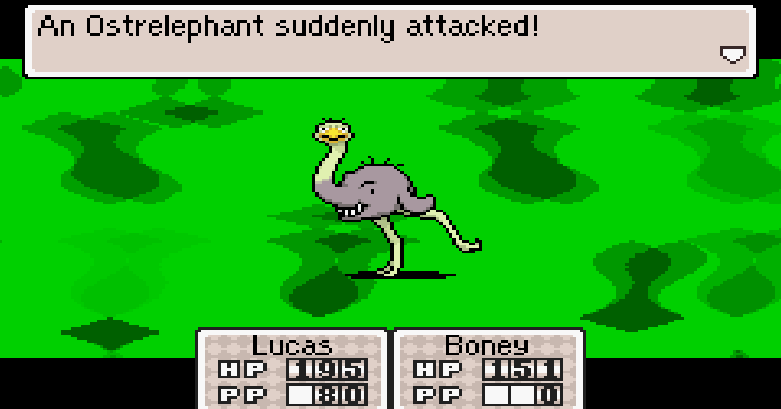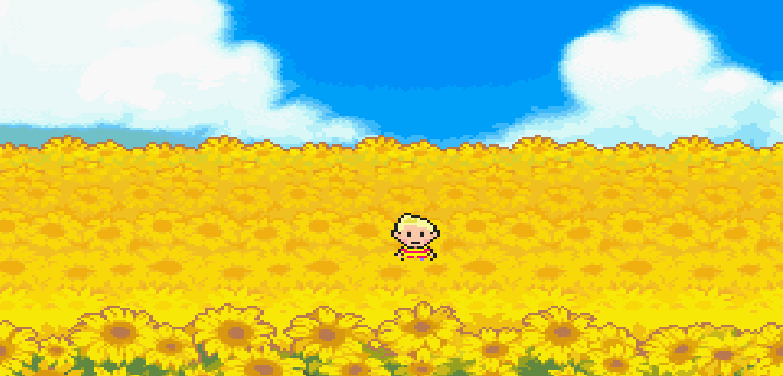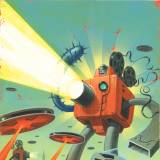Mother 3: A Game's Story
By Daneian 8 Comments

For all their merits, traditional JRPG’s haven’t exactly positioned themselves as videogames most cohesive narrative experience. One reason is foundational to the genre: the separation of world exploration and menu-based combat breaks player immersion from the story and characters. The other reason is true for the majority of games period: they all know how to implement a story but few understand how to exist as one. While still very much a traditional JRPG, Mother 3’s story takes root at its core, finding ways to incorporate all its elements into a whole that is surprising and emotional.
That’s not to say there haven’t been breakthroughs, though. Dragon Quest V’s devastating Act 1 climax, a scene where your hero warrior father is willingly beaten to death to save you, was framed entirely within its first person combat view as if it shot through his eyes, for a minute marrying story and gameplay. A few years later, Chrono Trigger would seamless transition from environment to combat, unifying the two disparate gameplay pillars and increasing the story’s potential impact. There have been notable exceptions, they just haven’t gone far enough.
You’re introduced to a perfect little nuclear family and their dog living in the Nowhere Islands rustic Tazmily Village before the title card even pops. Assuming you don’t just name them all after yours or someone else’s genitals, you’ll get the father Flint, mother Hinawa and the lovable Boney. But it’s the first two names, the brother’s Lucas and Claus, that might give you pause. Those are pretty different names for a pair of twins. Who would do that? Later, you’ll see that the boy’s personalities are just as different as their names- one is coddled and shy, the other strong and outgoing. But think on it and you’ll find that both names consist of the same five letters. By suppressing the urge to name one of the boys ‘Labia’, you helped create a metaphor. Lucas and Claus are made from the same stuff, just in a different way. It’s a neat touch and representative of the care and attention that went into the entire game.
Mother 3’s mastermind is the famous Japanese novelist/interviewer/creator of the Mother series Shigesato Itoi and if you don’t know the name you obviously haven’t witnessed the awe-inspiring devotion to his games by the galactic travelers of Starmen.net. Itoi’s expertise permeates every element of the work from the interesting villagers to the save system to the dialogue. The entire thing is wonderful. And tragic given the fact that Nintendo didn’t publish the cart outside of Japan because of the low-sales of Mother 2 when they released it a decade before as EarthBound and the advanced age of the Game Boy Advance. Thankfully, mega fan Tomato took up the charge and translated every line into an amazing patch for the GBA ROM. If Tomato’s work is half as affecting as Itoi’s original, there are officially at least two reasons to learn Japanese.
Tazmily is nestled just between the beach and the forest of Nowhere Islands, a small, intimate chunk of land that’s connected by geography rather than an overworld; a place just off the coast of A Link to the Past’s Hyrule. Set your footing- no really, you need to hold the ‘B’ button for a split second before you can dash, it’s awesome- and you can quickly run through the world. It’s a world so rich with colorful details that it might be one of the most gorgeous 2D sprite games ever released. While it’s easy to assume that it was an early example of the retro pixel boom, the sometimes blocky, sometimes sleek character designs are deeply expressive despite the minimalist aesthetic.
Itoi is a man who recognizes that story design is all about maximizing your narrative’s potential, so the adventure on Tazmily is divided into chapters. Offering an omniscient narrator, this inspired structure provides the freedom to regularly switch its main characters as it evolves, bringing with them new specialties to the gameplay and perspectives to the main plot. For the gameplay, the few key differences between each character are slight but actually quite profound, changing up both how they move in the world and their use in combat. It implicitly establishes that these characters are doing their own thing, their own way for their own reasons. Whether it’s a courageous duty to fulfill, a roguish mission to accomplish or an unwilling role to play, every chapter has its own logical purpose within the larger fiction and when they merge, it happens naturally. Even counting Dragon Quest IV, it’s a rare structure for a videogame but fits in perfectly with the more flexible form for a novel. That’s Shigesato Itoi.
And Itoi is a master who understands how to upend your expectations of how a story beat is supposed to play out in order to manipulate your emotions. At the risk of being cryptically cryptic, take a pivotal moment where our character is given horrifically bad news. By ‘conventional’ methods, the scene is written incredibly wrong. It’s so wrong that it manages to shock both you and the character, provoking an almost savage response in them that is gut-wrenching to watch yet appropriate for a situation that deserved a lot more delicacy than it was given. A scene that could have been rote ends up being quite powerful. Some half an hour later, you’re running with a companion who is desperately trying to lighten the rightfully heavy mood, but it’s a digitized ‘blip’ from your speakers and your companion taking credit for what you didn’t realize was a fart that finally breaks the tension. Mother 3 gets a grip on your heart and plucks at its strings.
Similarly smart details are given to the enemies, fleshing out a behavior and lending personality to what would otherwise be abstract actions. Deciding to place enemies on the map instead of random encounters further realize Tazmily as an island with an ecosystem and, more importantly, give players some agency over how they’re engaged. Catch an enemy from behind and the battle transitions with a green wipe and a preemptive round of attacks before they turn around, a dynamic that works both ways. Persona 3, released the same year, would also use the design, but wouldn’t inform you about your opponents until you loaded into the battle. Enemies are varied, ranging from pleasing to playful and- in the case of the Ostrelephant- downright disturbing.

Now, it isn’t exactly a secret that Mother was heavily inspired by Dragon Quest. Both view battles from the same first person POV and have you select your commands at the beginning of each turn and then watch them get executed down the line. That’s fine. It provides you with as much time as you need to make your selections while the lack of attack animations allow the combat to be snappy and the pacing quick.
Enemies have a tendency to group up, changing the dynamic, so it’s worthwhile to plan how battles are initiated. One of the best examples is the Battery Man and Minor Robot team up. If you spend your time focusing on Minor Robot, when his HP drops, Battery Man will jump inside and recharge him, removing the little guy from the fight altogether but presenting you with a revitalized foe. It’s cool and adds a nice layer of depth. While you can fight more than three enemies in a given battle, you never fight more than three at once. Any additional baddies wait in a nice little line off screen for their turn to jump in. When one dies, they all shift around and make room. It doesn’t happen too often, but it keeps combat challenging without being grueling.
In order to sell the characters place in the narrative, their abilities are learned through leveling rather than being tied to equipment or items, supporting their innate personalities instead of relegating them to a fate as interchangeable vessels. Yet it’s not just about one main character but a group of people, the full roster of which never exceed the party size you can bring into a battle. The eclectic members make up a comprehensive list of abilities that keep from being redundant. They’re all important.
So wait. I can take as long as I want to issue orders? Yeah. And the story dictates my party? Yaw. Isn’t that kind of boring? Naw! Because of the simplicity of its combat, every encounter could to be built with basic assumptions about your moveset. This isn’t a game where your enjoyment comes from strategizing the perfect party or juggling your time to execute commands. The joy of combat comes directly from the act of managing the fight in front of you. You know what you have so figure out what you need to do.
It might not sound like much initially, but the spinning slot-machine-esque HP bar, whose value tick down every time you take damage, goes a long way to making the combat engaging. Suffer a mortal blow and you have the time it takes for your health to hit zero to heal before that unit gets knocked out. In a way it approximates Final Fantasy’s revolutionary ATB gauge in reverse creating a sense of urgency that exists nowhere else in the game. The usually relaxing gameplay becomes a mad dash to recovery or victory.
Mother 3 loves music. Need proof? You can find a Boogie Woogie or Reggae Rhythm in treasure boxes. Hell, enemy types come with their own theme music and every hero’s regular attack is accompanied by a sound tuned to their own instrument. Pay attention and you can time your attacks to the beat, stacking what would have been one hit up to a possible sixteen. The sound of your instrument combined with the enemy’s beats creates a little song. If you’re not musically-oriented, putting your opponent to sleep lets you hear their heartbeat and clue in to the rhythm. It may be more Rhythm Heaven than Paper Mario but adds action to the combat, attaching gameplay to an element that already exists and not by stapling on additional systems.
The story works so well because its events alter the fabric of the world in substantive ways. Here’s a brief tale about the Yammonster. The first time it appears is during a forest fire, this unassuming little tuber that you’ll only fight if you run right into it. You come back to the area a little later and find a new enemy in its place, an evolution accompanied by new moves, higher HP and a threatening new look. The fire cooked the Yammonster into a Baked Yammonster. Tazmily is alive and reactive, full of details large and small where so many others are defined and static.
But it also knows when to pull back and let the gameplay be the story. A chapter devoted to collecting Plot Points is a stellar example. Even more than for its steady stream of new and interesting content, the section is remarkable for its sheer length. It feels long. Like, to-the-point-of-fatigue, long. Can it be that Itoi, who has more than proven himself capable of constructing a tight and concise plot up to this point, padded this one chapter out on accident? Considering the quality of the writing throughout- including a moment where you enter the ocean at the waves and keep walking- the answer to that question is ‘no’. This sequence is supposed to be exhausting. It’s a competition between light and dark using classic best-of rules, a test of endurance for both you and the hero. Its length organically fuses gameplay into a story.
Mother 3 uses every tool in its box to build its tale. But a story is so much more than the way its told, so let me summarize Mother’s in the best way I know how: it’s a funny, sad, whimsical, deep, touching, fun, cool, off kilter, playful, dark and surprising game about technology, nature, commercialism, progress, people, friendship, family, evil, heroism, the past, the future, life, death and love. It’s beautiful. It does something extraordinary: it makes you think. With an otherwise throwaway line of text, it made me ask myself whether or not the fact that the family dog wasn’t trained, couldn’t shake a person’s hand, meant he was free or meant he was wild.

